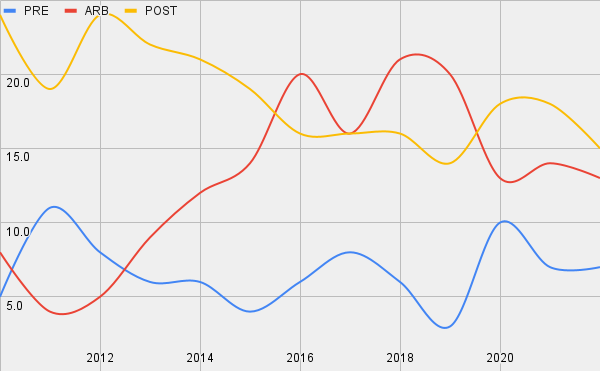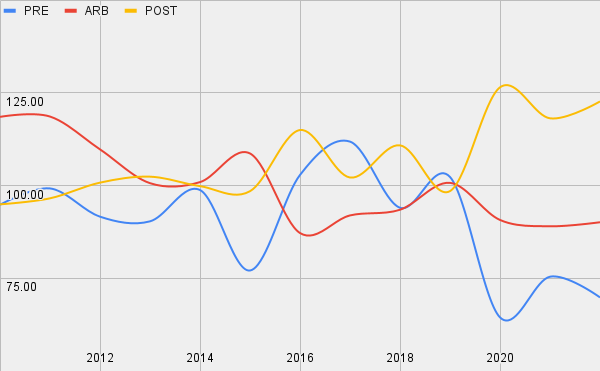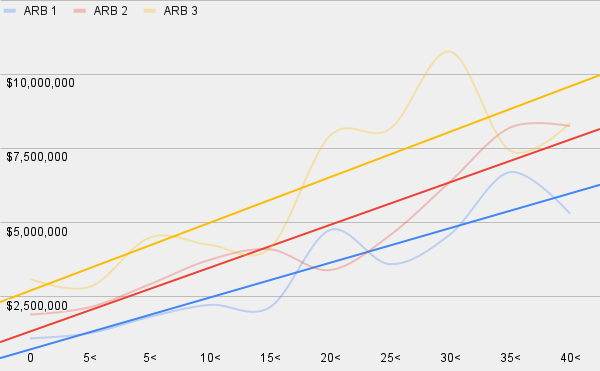Baseball fans are well aware of the fact that MLB teams are always rethinking bullpen usage. Whether it’s the rise of the “opener,” pioneered by the Tampa Bay Rays in 2018, or the decline of the dedicated closer, teams are placing greater emphasis on things like leverage indices and pitch quality metrics, and less emphasis on things like experience and role. It may come as a surprise, however, that over the past three seasons, there has been a league-wide trend away from using junior relievers in save situations.
In this article, I’ll analyze this trend and show how it relates to the economics of service time and salary arbitration. As with most baseball trends in recent years, things make a lot more sense when you follow the money.
Out with the New, in with the Old?
To begin, let’s look at the distribution of save shares when compared with service time. In order to get a bird’s eye view, I looked at every MLB save recorded since 2010 alongside the service time of each reliever at the start of that season.
For the few players whose service-time data wasn’t readily available, I provided an estimate based on their MLB history and ensured that no one in this category had signed an extension or entered the league through alternative processes. Since these players usually accrued very few saves, the numbers below were not significantly affected. This bird’s eye view, however, doesn’t yield any significant results: average service time weighted by saves has remained fairly constant since 2010.
If we place players into categories based on their arbitration status, however, things become a lot more interesting. I placed every reliever into three buckets: pre-arbitration (PRE), arbitration-eligible (ARB), and post-arbitration (POST).
I first drew these categories from the player’s service time at the beginning of the season. Any player with 2 or more years of service time at the beginning of the season is placed in the ARB bucket, since arbitration eligibility begins after the third year. Players in the POST bucket either begin the season with 5 or more years of service, sign early-career extensions, or enter via international free agency. With players categorized accordingly, a recent trend emerges:
Percentage of League Saves by Arbitration Status and Season

Contract Sources: Spotrac; MLB Trade Rumors; Cot’s
As the graph shows, the percentage of saves distributed across players in the ARB class have been on a gradual incline over the decade, while those in POST have been gradually declining. In 2020, however, the trend reversed. Over the past three seasons, post-arbitration relievers have lead the league in saves by a wide margin.
The three-year sample may suggest that this is only a small statistical variation. After all, we are talking about a small group of shares distributed across 30 MLB teams. If this recent trend is at all significant, we should be able to pinpoint the change more precisely. One potentially useful approach would be to look at the number of pitchers saving games:
Number of Pitchers by Season with (1) at least 1 Save, (2) at least 10 Saves, (3) and at least 20 Saves
 (1) The first of these three graphs shows how MLB teams increasingly allot saves across a wider distribution. These days, its becoming rare for a team to rely on one dedicated closer over a whole season.
(1) The first of these three graphs shows how MLB teams increasingly allot saves across a wider distribution. These days, its becoming rare for a team to rely on one dedicated closer over a whole season.

(2) The second graph, though, points to a possible cause for the trend change highlighted above: teams distribute saves to an increasing number of pitchers in the pen, but in recent years, teams have increasingly given the bulk of their saves to post-arbitration closers.

(3) As you can see, the trend becomes more clear as the minimum save total increases. It would seem teams are more comfortable given large sums of saves to pitchers post-arbitration.
Contract Sources: Spotrac; MLB Trade Rumors; Cot’s
The 2020 shift becomes all the more stark when we set a minimum 10 saves (or 4 saves in 2020) and adjust for league-average saves for pitchers with a minimum of 10. In the following graph, I’ve done just this, setting league average at 100 (like any good + stat):
Adjusted Saves+ for Relievers by Arbitration Status (min 10 SV)

Contract Sources: Spotrac; MLB Trade Rumors; Cot’s
Yes, save shares are more widely distributed, but the last three years show a clear preference across MLB for giving the bulk of saves to post-arb pitchers. Why? The answer is simple: saves come with a cost.
Arbitration and the Cost of Saves
In recent years, there has been a greater appreciation for the plight of the relief pitcher. Relievers are regularly bussed from one league to another and from one team’s bullpen to the next. What’s more, RPs rarely even reach free agency, and they fair poorly in arbitration hearings. The exception, however, is saves. Saves in the previous season cost a lot in arbitration, as Matt Swartz, the creator of the MLB Trade Rumors’ arbitration model has frequently pointed out.
In order to see how much, let’s take a look at the median salary during an arb-eligible relief pitcher’s first, second, and third arbitration years and compare it to their saves in the previous season. Since we aren’t modeling arbitration settlements, all salaries are relevant, not just settlements. After all, the threat of arbitration alone gives players meaningful negotiation leverage:

Contract Sources: Spotrac; MLB Trade Rumors; Cot’s
The graph shows a clear picture: if you want to keep a reliever’s cost under $5 million, your best bet is to keep them from accruing 20+ saves in the previous season. Mean salary and minimum salary show a similar trend line.
Saves are a costly category in arbitration, so we would expect this to enter into organizational strategy. Moreover, save-shares don’t track with standard performance metrics like K-BB% or WAR and even the most progressive organizations (like LAD, MIL, and NYY) have shown their intention to employ more traditional closers. As I’ve written about elsewhere, strategic decisions aren’t merely the product of competitive optimization. Baseball is a business and teams don’t primarily make money by winning baseball games.
Why 2020?
There are two obvious reasons why 2020 might have been a catalyst in changing bullpen usage. First and foremost, the COVID-19 pandemic shortened the MLB season and, as a result, decreased team revenues. As a result, teams took pains to cut costs where possible, as infamously exemplified by Arte Moreno, owner of the Los Angeles, who furloughed most of his scouting department in advance of the MLB draft.
It’s not hard to imagine ownership finding a few odd millions by taking on more control of who managers use in save situations. In addition, its worth noting that players were granted prorated service time during the shortened season, meaning that players were able to enter arbitration eligibility earlier than MLB had initially proposed.
In a similar way, we might expect cost-saving measures as a result of the anticipated 2022 CBA. Increases in base salary and “competitive balance” tax, anticipated compromises in the collective bargaining agreement, also entail increased dollars in arbitration. What didn’t change in the CBA, though, was basic structure of arbitration. Despite MLB’s efforts to determine salary by WAR (which doesn’t consider saves), the decades-old process remained largely the same.
As a result, whatever lessons were learned in 2020 were relevant to the subsequent seasons, much like how other market trends started during lockdowns have perdured in day-to-day life.
Complicating Factors
The trend outlined above is hardly cut and dry; it emerges in the aggregate. What other factors might determine the distribution of saves? In order to assess this, I looked at every instance in the 2021 and 2022 season where a team gave at least 20 saves to pitchers in the PRE and ARB buckets. What’s shocking is just how rare this actually is:
Some of these situations can be explained by sheer necessity. In 2022, the New York Yankees entered the season handing Aroldis Chapman the closer role (a position he had held for years). Chapman’s poor health, ineffectiveness, and relationship with management resulted in a lost job, and the Yankees turned to Clay Holmes with Zach Britton on the IL. In 2021, Cleveland’s only alternative to its pair of dominant rookies was a post-prime Bryan Shaw. A similar situation was had in St. Louis.
Other situations are marked by elite relievers forcing the issue. Edwin Diaz and Josh Hader are the only pitchers here with 30+ saves. Less obvious situations are the 2022 San Francisco Giants and the 2021 Oakland Athletics. It’s worth remembering, though, that the 2021 Athletics entered the season with playoff ambitions (a time that seems far more distant given the state of their 2023 roster). The 2022 Giants, on the other hand, might simply be playing out the same strategy employed by another cost-sensitive organization: the Tampa Bay Rays.
Across 2016 and 2017, Alex Colomé saved 84 games for the Rays. The following season, Colomé reached arbitration eligibility and signed a $5.3 million contract. He was soon traded mid-season and the Rays handed the job to veteran pitcher Sergio Romo. In 2019, a pre-arbitration Emilio Pagán accrued 20 saves, the most of any Rays pitcher, but was traded the following offseason before the arbitration deadline.
During the shortened 2020 season, no reliever accrued more than 6 saves. In 2021, though, the Rays were back to it. Diego Castillo saved 14 games and was subsequently traded at the deadline in advance of his first arbitration year. In 2022, no one player reached double digits.
Interestingly, though, Pete Fairbanks was signed by the Rays to a long-term extension, buying out his arbitration years. The move may signal a new usage for the right-hander since any accumulation of saves will no longer entail unforeseen costs. Will Fairbanks be the first Rays reliever with 30+ saves since 2017? Only time will tell.
Situations to Watch
Teams seem to be deploying a few interrelated strategies: (1) Teams generally choose to give save-shares to post-arbitration players. (2) Teams sometimes employ pre-arbitration pitchers in closer roles before trading them for prospect depth. (3) Teams (like the Chicago Cubs last year, and possibly the Oakland A’s this year) sign relievers for their closer roles instead of giving the job to emerging young talent. (4) Teams are looking to extend relievers in order to buy out arbitration years (like Cleveland did with Clase or Tampa with Fairbanks).
A few interesting bullpens to watch this year are the St. Louis Cardinals, Miami Marlins, and Los Angeles Dodgers. The Cardinals’ Ryan Helsley recently lost his first arbitration hearing after accruing 19 saves. His teammate, Giovanny Gallegos, recently signed an extension with the team.
Assuming Gallegos returns healthy, don’t be surprised if he earns a larger share of the saves than anticipated. Helsley is certainly in line for save situations, as he was utilized on opening day, but Gallegos is a viable closer and Helsley’s luck during arbitration will only increase with additional service time.
The Miami Marlins gave their first save of the season to A.J. Puk instead of the soon-to-be-free-agent Dylan Floro. The Marlins may look to increase Puk’s trade value in order to bolster their diminishing offense, or they may let Floro take the lion’s share of saves in order to save down the road.
The Dodgers find themselves without a dedicated closer, despite their preference for one over the last several years. Daniel Hudson, who is post-arbitration, may take the role upon his return, something that many anticipate, but may be even more likely given the Dodger’s largely pre-arb and arb-eligible bullpen.
In Closing
Speculating about closer roles will never be a science, but if there is one takeaway from the foregoing analysis, it’s that arbitration is affecting save-shares more than we’ve been acknowledging. Arbitration eligibility isn’t just a tie breaker, in the aggregate, it’s a determinative factor.
Given the well-known shift toward high-leverage use for a team’s best relievers, we might expect something of an unholy matrimony in years to come; teams may use high-leverage strategies as a rhetorical device for limiting the threat of arbitration hearings. In the meantime, keep an eye on the save totals of pre-arbitration and arbitration-eligible relievers, there won’t be many who accrue 20+ saves.
I’m grateful to Matt Swartz for his invaluable insights and for fielding some questions while I developed this piece.

